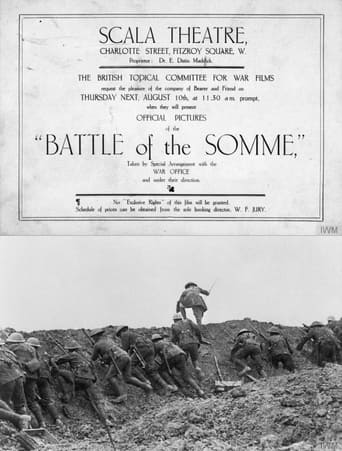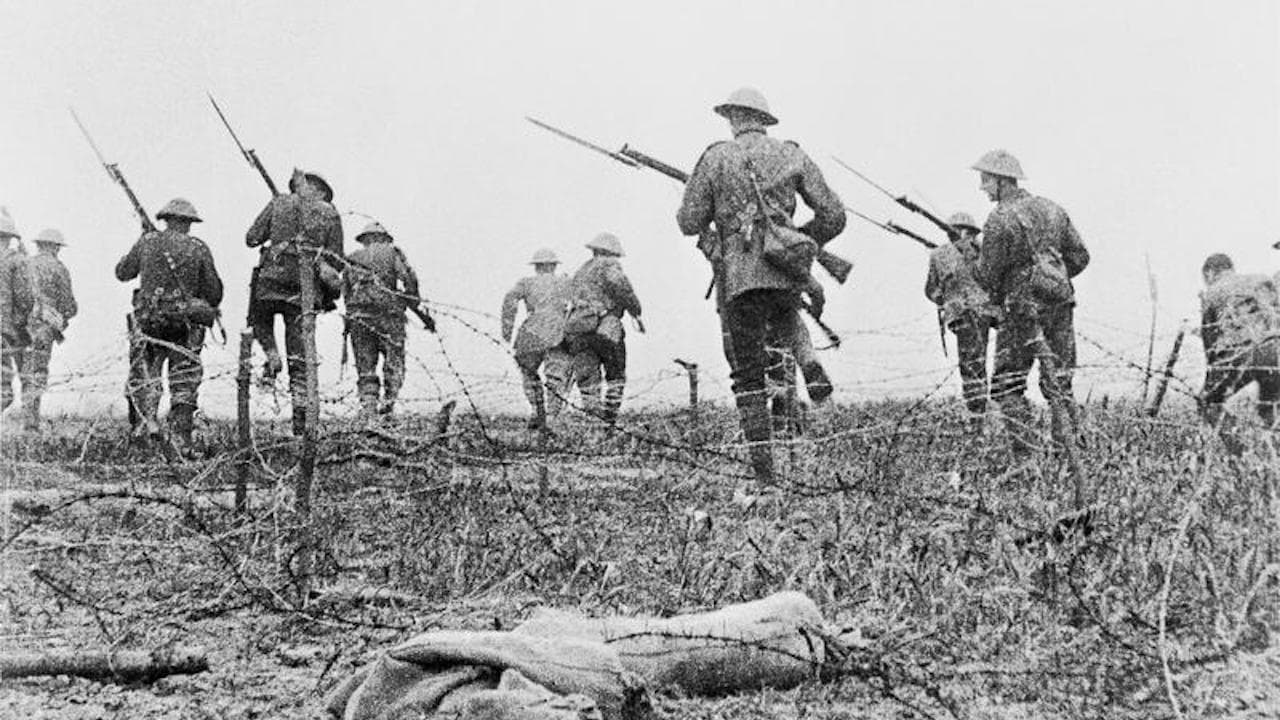stantheman1961
Yes some of these scenes were "Re-Enacted" for Propaganda/Enlistment purposes but let's not forget that every single soldier in this Movie, Documentary call it what you will are now dead, Most probably died at that time in that place or in later battles. Much footage was cut from the public version, as the War Office wanted the film to contain images that would support the war effort and raise morale.It still manages to portray the horrors of war and its utter futility, did we learn our lesson No,no we didn't This is a remarkable piece of Cinema that has now passed from living memoryLest We Forget
Nick Pett
Last night I went to the Queen Elizabeth Hall on the South Bank to watch a screening of the digitally restored print of this silent film, accompanied by the Philharmonia Orchestra, playing music written by Laura Rossi. I was nervous about the application of music to a silent film, as I am about the application of music to any film, but more so. Whilst there can be no doubt about the power of music to augment the impact of a scene, this manipulation of our emotions can also be crass, offensive, or a complete failure. There were times during this film when the music was the perfect partner - the rendering of the wind over the battlefield was incredible and terrifying. But the accompaniment of drum-bursts for the firing of artillery pieces was less-than-impressive. And there were moments when i wished the film would be left to speak for itself, such as the filming of the first charges; some men slid back down the muddy faces of the trenches, one thought initially because they had lost their footing, but it was soon clear that they had been killed before they had even set foot in no-man's land. For me, this moment would have been made powerful by silence, because there are no words or sounds for the sadness and futility of such things. Finally, on the music, the accompaniment of cheerful marching tunes when the lads marched back from "a successful attack", left me with a sour taste, but i think this says more about the film than the music. Laura Rossi could hardly provide sarcastic or barbed rejoinders (in the manner of Kipling or Sassoon's poetry) to these moments of propaganda. This is where the film falls down (but is still fascinating and valuable) in that, for the most part, it is content to talk up the British Army, the power of bombardment, and the success of its attacks. Even the images of dead men and horses are tempered by the smiling faces of 'jolly tommys' and the jaunty, cheery tone of the titles boards. What this unique visual record of the battle needs is to be seen in context, against the terrible losses of battalions such as the Accrington Pals, and the pitiful gains of this style of warfare. I never fail to be impressed, however, by the efforts of the institutions on the South Bank to bring amazing documents like this out of obscurity. Well done to them, and to Laura Rossi for her attempts to soundtrack this one-off film.
FerdinandVonGalitzien
The documentary is a genre that was born at the same time as the cinema itself because at the beginning the cinematographer was there to reflect and capture daily events of varying degrees of importance: the arrival of a train to a station, the exit of the proletarian masses from the factories or even the exciting view of the parishioners going in and out of church. It followed that the new invention was a perfect instrument to display images, costumes and events that would interest older people as well as the new long haired generation.But "The Battle Of The Somme" it is not a trivial show of mundane events during the early times of the cinema; it is a document of a great importance for film history and history itself. The film depicts the terrible and largest WWI battle; it happened in a long front north and south of the River Somme in northern France and was a huge battle in which more than a million people from different nationalities died. The film is an exceptional document of the horrors of war that shows the great magnitude of that that tragic war or really any war. This conflict changed Europedrastically ( the end of the innocence ) and, even worse, rather than deter future wars, it only led the way to the even more terrible WWII. The film was photographed, not directed,-there is a big difference between those terms- by the British official cinematographers Geoffrey Malins and John McDowell whose primary intention was to film such an important battle but since they ended up shooting quite a lot footage, the British Topical Committee for War Films decided to release it as the first feature-length documentary film that depicts war combat. The film is structured and divided into different parts in which can be seen the different war preliminaries and the consequences of the battle, besides the tactics and arms used in the WWI. Since it was released during the war the movie functions as a propaganda film for the British Army. And of course it exposes to the civilians the horrors of war that was still raging. The film was shown in Great Britain and many countries of the world while the battles continued in France."The Battle Of The Somme" it is an exceptional war document of historical importance, a silent film that, although it seems a redundancy, doesn't need words.And now, if you'll allow me, I must temporarily take my leave, because this German Count wants to wish that those disasters of war never happen again.Herr Graf Ferdinand Von Galitzien
dfarmbrough
This film provides valuable insights into several parts of history that might otherwise be forgotten. It does not tell the whole story, but then the whole story is by definition, untellable. There is a saying where I come from that history is always written by the winning side. Therefore this film to some extent tells it from the British point of view. The treatment of German Prisoners Of War by both the British forces and by the film crew is compassionate, and we are left with the feeling that they are not mere ciphers, but human beings. In watching this film, several myths about the Great War were debunked. I learned that very few of the German soldiers sported comedy pointed helmets (most wore the type Paul McCartney wears in his Pipes Of Peace video'). The usual scenes of Trench battle we see in film and television programmes show poor visibility with the trenches shrouded in mist, but this is probably a cinematic convention brought about by budgetary constraints rather than a desire for accuracy. The other myth that is exploded by this film is that the ordnance used in this war was rather primitive, hence the need for foot soldiers. This couldn't be further from the truth, with very big guns with fifteen inch diameter shells being fired over very long distances. When one considers that the majority of the large guns had to be transported (although in some cases by horsepower) by hand, dismantled and moved, then reassembled on the muddy battlefields, all whilst under fire, the engineering and logistical feats seem all the more remarkable. The interesting thing about this film is that I would happily sit through this and enjoy it, but I wouldn't be interested enough to read a book about the Battle, nor to research the subject at the imperial War Museum. This is a good way of making history come alive and would be of interest to both the young and old.The Museum's restoration is very good. The picture frame rate seems to be correct, and there do not seem to be any jumps or major tears. However there are a number of minor scratches that could have been repaired with a little more effort, and it jars that this halfpenny of tar has spoiled an otherwise seaworthy ship. The only reason I can think that the remainder of the scratches were not removed is a desire to keep the medium analogue rather than digital. A digital conversion would have rendered the clean-up work a lot simpler, but might present problems for presentation purists. The upright piano music used for this restoration is ideal for the purpose. It not only gives a feeling of authenticity, but also lends the correct atmosphere to the film. Top marks for restraint go to the Museum for resisting the temptation to dub on sound effects. If I wanted to hear BBC Sound Effects Volume 12 I would visit my record library!


 AD
AD
